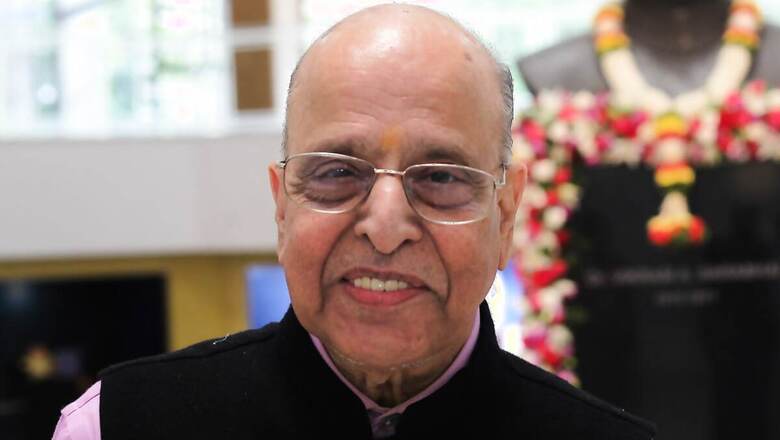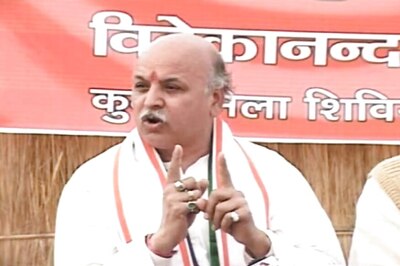
views
Dr K Kasturirangan, the rocket scientist who drafted India's new education policy (NEP), has come in for praise for advocating a major revamp of how our children learn. Whether it is about de-stressing Board exams or bringing in mother tongue as the medium of instruction up to age 10, or allowing Ivy League institutions to set up campuses in India, the policy seeks to shake up the system as we know it. The policy even wants Indian universities to compete with the Ivy League.
Speaking with CNN-News18, Dr Kasturirangan explained many intricacies of NEP 2020 and the motivations behind it. Edited excerpts:
You have talked about medium of instruction in the mother tongue or local language. But considering the diversity of Indian languages, and how people do migrate from state to state, is it practical?
First of all, we have considered language in early school education because there is a three-language policy. The second is with respect to its richness — the country has tremendous richness in its language and therefore we need to preserve it especially as the country progresses socio-economically and culturally. And there are the international linkages that we are developing much faster with other countries — language learning becomes imperative with respect to this.
Coming to the specifics about what we have recommended, about what we want to retain from the earlier policy of 1992 — is the fact that it is a three-language formula. We have suggested what you may call mother tongue or local or home language or the regional language: one of them could be the choice so far as the medium of instruction is concerned.
The reason is not far to see: we have found that a child when born starts thinking in the mother tongue; it is not that the child starts thinking in English. There is a lot of work that has gone into this between the time when we discussed the medium of instruction years back and today. Today, we have much better clarity with regard to the comprehension, the cognition and those kinds of qualities that the child has got with age. So taking that into account, and the fact that much better comprehension and cognition are possible in the mother tongue because you think and talk and live in the mother tongue...that's one of the reasons. And there is very strong evidence of this and I'm not telling this evidence only with respect to this country only, but in countries like France, Germany where even Nobel Laureates have admitted that their understanding of science through their mother tongue has really helped them understand principles much better than learning it through a foreign language.
English of course is a question — whether we must continue to have English as a medium of instruction. Yes, the choice can be given, but after years and years of learning, 15 per cent is the English-speaking population.
We have a large number of people who are capable today, who would like to learn and therefore to adopt a language which is the best under the circumstances. We have considered all these things in finally making the recommendation that we can have the medium of instruction for the school. With respect to the mother tongue, alternately, it can be the home-spoken language... or the local language or lastly we can even consider what we call the regional language.
This is the basis on which we have recommended:
It is still a three language formula,
It is still flexible,
And there is no imposition of any language so far as learning is considered in the school.
But those countries you spoke of are those that have single languages. India has diverse languages. So it may be difficult to implement.
You should understand my own case. I am a Tamilian, born in Kerala. Early school education was in Kerala, my main school education was in Mumbai, I had my research career in Ahmedabad, my professional career in Bengaluru, further professional career in Delhi and now I'm back in Bengaluru. I never found the kind of considerations that you raise about the mobility of Indians.
Certainly, there is a phase in which you can learn languages a little better — that is between 3 and 8 years. You should certainly stimulate those parts of the brain for language-learning capability. Once you have that, I think it will not become a bottleneck so far as going to other languages for learning.
The country has witnessed mobility right now in the educational system which belies many of these worries that people have about the choice of language for instruction.
Certainly there is Hindi, there is English, there is a local language. Between the three, one can find a solution in the context.
This is the basic assessment we have made on a scientific and rational basis.
The policy says it wants to make Board exams "low stake". But there is still a Board exam and students do have to write it.
You have to make Board exams low-stakes. Currently it is such high-stakes that you can miss regular classes, but you cannot miss coaching classes. This is ridiculous. This is exactly what we are trying to address.
What we are trying to do is you evaluate students not on the day of one year completion of studies, and suddenly ask him to spill over whatever he learnt for one year in terms of recalling it from memory. We are trying to have a formative way of evaluation. Evaluation will be a continuous process all through, and the ability of the student to take the exam whenever he is confident that the particular subject he has mastered so he can be evaluated for that — these are the kind of things that will enable the student to stand and present his credentials for higher education. So that it is not an evaluation of a one-time nature where rote-learning becomes the basis and mostly evaluation where you start depending on coaching classes and create stress for yourself well ahead of exams. And in the process don't really test the true potential of the student. That is what we want to avoid.
But the National Testing Agency would do the same — hold an exam.
The National Testing Agency is finally going to be an all-encompassing agency.
NTA is currently being envisaged as the main exit window through which you can evaluate where you fit in, in the overall scenario of higher education — whether mainstream or professional or vocational. I think this will really bring in a multi-disciplinary approach and evaluate a youngster not only with respect to the specific area in which he is trying to get in, but whether he has the ability to be creative and he can develop 21st century skills of creativity, originality, problem-solving and communication.
So this is the whole concept of testing. So it is not only writing a competitive exam in a specific area and then trying to get an entry.
NEP aims at getting top universities to set up bases in India. How do you see this impact student choices in, say, 10 years from now? Will India emerge as a preferred higher education destination?
Currently, the policy provides for working with foreign institutions that are reputed ones. It is not institutions that are looking for partnerships and nothing more than that — that is not the whole idea.
When I talk of the 100 Ivy League institutions in the world, I'm talking of the standards you set for Oxford and MIT and Cambridge and Stanford and universities of that kind.
You need to get institutions of that kind to come to India and start courses and give an opportunity for them (students) to face the exam system that they have there. So you can really do this without the student physically going abroad and trying to take up higher studies abroad because of their better nature of imparting education in these schools. But this will be coexisting with the system we have recommended.
Our restructuring and reconfiguring of the higher education system involves both research and learning kept at the same level: learning with research supporting it.
And that can even give competition to many of these institutions. In the next 10 years we want to have a few of them show that India can build this kind of institution. Building first-class institutions of the class you are talking of in the world, they have taken many many decades. Typically, Cambridge or Oxford are all hundred-year institutions. We only have an Indian Institute of Science that is a hundred years old.
But today with modern methods and technology and the kind of development we have done on educational tools, it is possible to accelerate the process of going to the top. Certainly Indian institutions are going to enjoy that privilege with this policy (NEP 2020) being put in place and providing the necessary support to create these kinds of institutions.
So when we talk of bringing other institutions from abroad, we are talking of a competitive regime which is not very far, in terms of implementing this policy and trying to compete with them.
You have talked of vocational training from class VI. Is that not a bit early?
There are many other applications to which a large workforce must be added. Now in this context, vocational training is based on a certain skills framework — and it is a fairly expansive and extensive skills framework that has been formulated.
There may be limits of it— maybe it should be learnt even earlier.
You put the candidate in a position to make judgements and acquire knowledge that can be directly applicable to certain types of jobs — whether it is craft or a limited amount of architecture , certain aspects of environment, certain aspects of agriculture, certain aspects of support in hospitals and some areas of manufacture and so on.
So there are many areas in which a secondary-level education coupled with a skill component, where you also interface with local systems of industries and other enterprises like hospitals and so on, would create a workforce that is meaningful, useful and contemporary. That is the concept for school education coupled with skill education.
Now having done that much, the school can also prepare them for higher education. That is where we have tried to bring skill education and vocational education into a fold where it becomes part of undergraduate education.
We want to strengthen the entire vocational curriculum — you could do mainstream education like arts and science or professional education like medicine or law — you also bring in vocational education, and provide higher levels of learning that could be brought to skill use. For example, artificial intelligence or machine intelligence and many factors that are today available to bring a certain level of skill capability.
The most important thing is integrating skill education and professional components into mainstream education. It is still a job to be done — this has to be worked out between the national skills development framework and mainstream educational institutions.




















Comments
0 comment